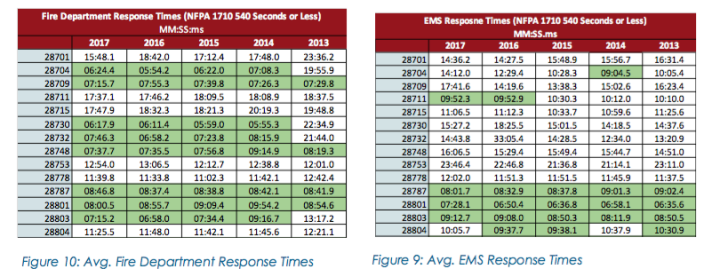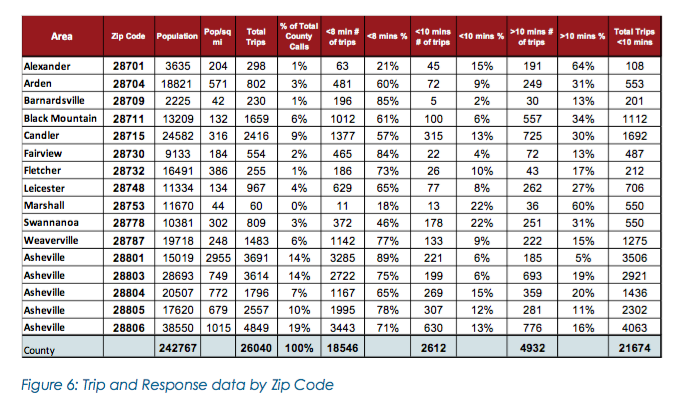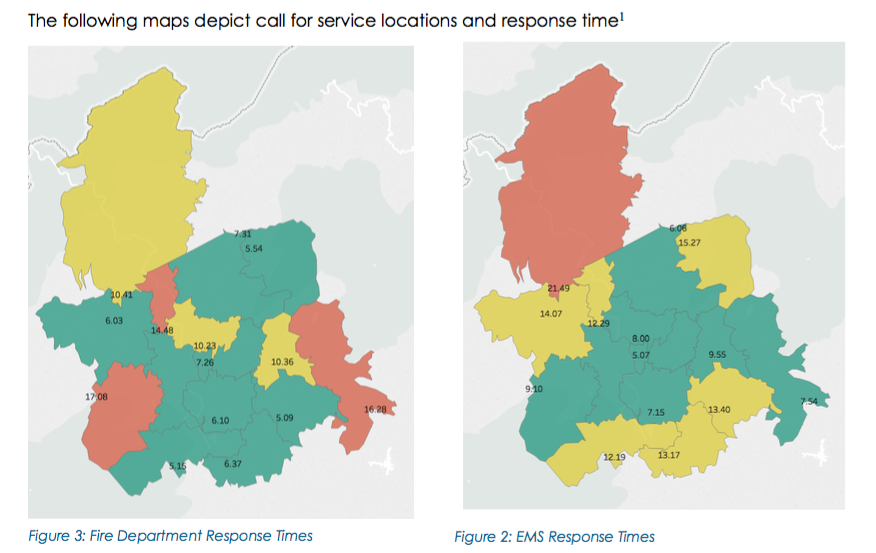There’s always room for improvement.
At the Tuesday, April 17, meeting of the Buncombe County Board of Commissioners, members of the board will hear the results of an analysis of future and current EMS needs. While Buncombe County’s EMS reaches many areas within an acceptable timeframe, response times in other parts of the county lag behind certain standards.
Management Solutions for Emergency Services drew on Buncombe County EMS data from 2017 to evaluate performance, using standards set by the National Fire Protection Association as a yardstick. The NFPA says that units staffed with a first responder or a “higher-level capability” should respond to an emergency medical incident within five minutes 90 percent of the time, and an advanced life support service should respond to an emergency medical situation within nine minutes 90 percent of the time.

County staff say that, measured against standards set by the NFPA, Buncombe has a strong EMS system. At the same time, staff acknowledged that the county’s system faces challenges with response time and backup staffing because of the county’s large geographical area. Overall, response times in Buncombe County last year were slower in rural areas, which the report says parallels a nationwide study published in 2017. That study shows “the average wait time … for EMS to arrive in suburban and urban areas was 6 minutes, while the average wait time in rural areas was more than double that, at 13 minutes.”
According to the report, EMS responded to incidents in suburban and urban parts of Buncombe County in 9 minutes or less 86.3 percent of the time and to rural areas in 9 minutes or less 72.6 percent of the time in 2017.
The time parameters set by the NFPA, the report says, “are primarily based on the fact that specific clinical intervention is necessary if a cardiac arrest is to be survived. Cardiac arrest can result in brain … death within 4 to 6 minutes.”
The types of units that make up Buncombe County’s EMS providers could affect whether the NFPA standards are realistic for this jurisdiction, the report acknowledged.

“It is important to note that this standard was designed for career fire departments dispatching EMS, not rural volunteer fire departments dispatching EMS, which you have,” the report says.
Management Solutions for Emergency Services wrote in the report that it is not aware of any EMS agency that is totally compliant with the NFPA standard.
“The cost for an agency to be in complete compliance with all applicable standards is simply not feasible,” the report says.
The report, which cost $8,000, was authorized at a public meeting of the Board of Commissioners; it also assesses the impact of adding more for-profit service providers to the county’s public/nonprofit system.
According to county staff, two of the major takeaways from the report are that ambulances in some districts aren’t used as efficiently as they could be, and adding more ambulances may not improve service levels unless specific, less densely-populated districts are targeted.
“Buncombe County has already implemented a respectable system that is larger than other counties of like kind,” the report says. “To improve response times, the most economical solution would be to move resources into the 28701, 28715, 28753, 28778 and 28804 zip codes.”
The report can be read in full here.
In other business
The board is scheduled to proclaim April Child Abuse Prevention Month. The proclamation says the county department of Health and Human Services had more than 4,140 children reported abused, neglected or dependent last year. Statewide, the number of abused, neglected or dependent children was more than 160,000.
Commissioners will also hear a report on the county’s Youth Opioid Summit, which took place on April 12 at Western Carolina University’s Biltmore Park campus. They will also hear an update on the North Carolina Real ID program, which in the future will allow residents to board a commercial airplane or visit a federal facility like a military base without providing additional documentation.
The Buncombe County Board of Commissioners will meet at 5 p.m. on Tuesday, April 17 at 200 College St. in Asheville in room 326. The full meeting agenda and supporting documents can be found here.




Before you comment
The comments section is here to provide a platform for civil dialogue on the issues we face together as a local community. Xpress is committed to offering this platform for all voices, but when the tone of the discussion gets nasty or strays off topic, we believe many people choose not to participate. Xpress editors are determined to moderate comments to ensure a constructive interchange is maintained. All comments judged not to be in keeping with the spirit of civil discourse will be removed and repeat violators will be banned. See here for our terms of service. Thank you for being part of this effort to promote respectful discussion.